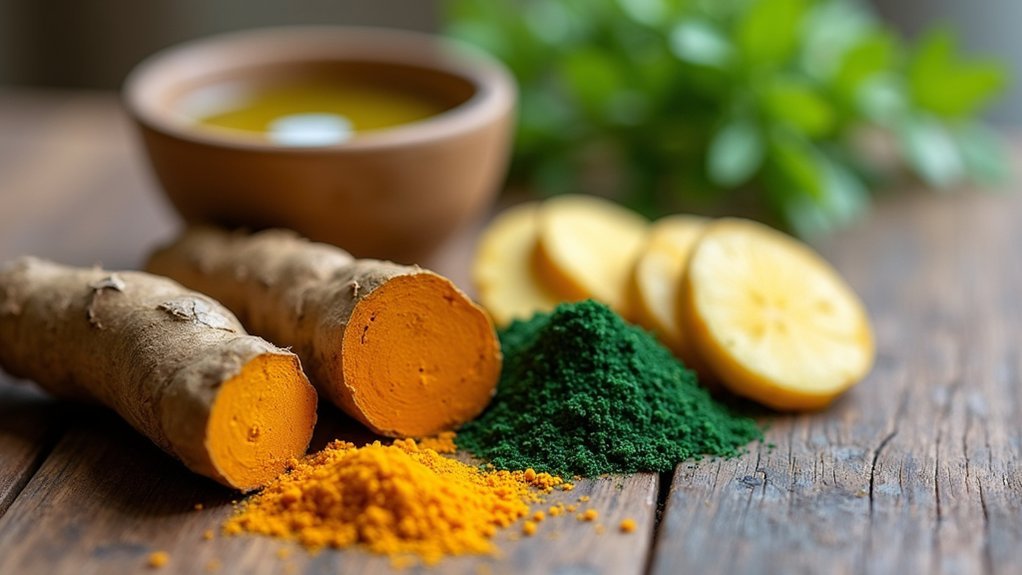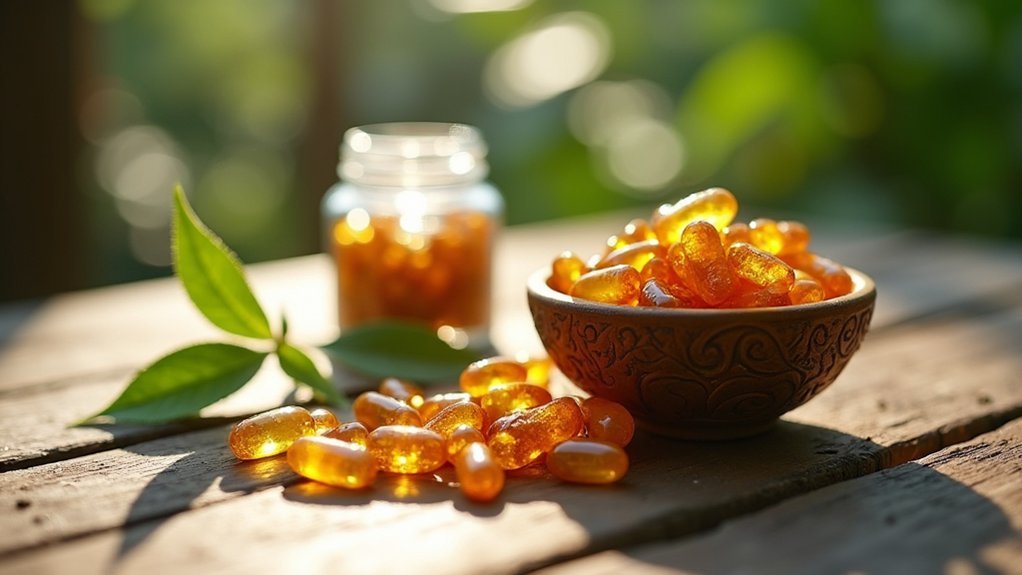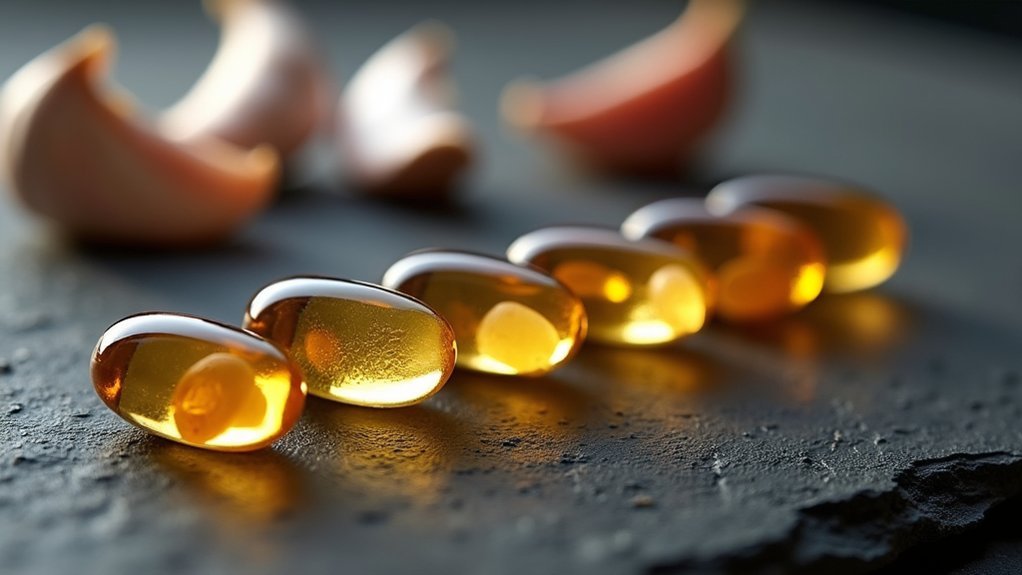The most effective anti-inflammatory supplements for joint pain include turmeric/curcumin (500-2,000mg daily), omega-3 fatty acids (over 2.6g/day), and the glucosamine-chondroitin combination (1,500mg/400-1,200mg respectively). You’ll also find significant relief with SAM-e, which matches NSAIDs’ effectiveness with fewer side effects, and Boswellia serrata for blocking inflammatory enzymes. Devil’s claw offers traditional herbal support, while avocado-soybean unsaponifiables help slow cartilage degeneration. Combining these strategically can maximize your anti-inflammatory benefits and joint protection.
Understanding Joint Inflammation and Natural Relief Options

When joint inflammation strikes, it manifests through five telltale signs: pain, swelling, warmth, redness, and stiffness that can greatly impact your daily activities.
This inflammation stems from various causes including injuries, autoimmune disorders like rheumatoid arthritis, and infections.
What sets inflammatory arthritis apart from degenerative conditions is your immune system’s involvement—it mistakenly attacks joint tissues, creating chronic inflammation that can affect other body systems. Beyond joints, rheumatoid arthritis can damage skin, eyes, lungs, heart, and blood vessels throughout the body.
Natural anti-inflammatory relief offers you an alternative approach that targets inflammation and pain while supporting joint function without typical medication side effects.
These supplements work through multiple pathways: modulating immune responses, providing antioxidant support, and preserving cartilage.
You’ll find the most effective strategies combine dietary changes, targeted supplements, and physical therapy tailored to your specific inflammatory condition.
Glucosamine and Chondroitin: The Classic Cartilage Support Duo
You’ll find glucosamine in two main forms—sulfate and hydrochloride—with sulfate being the most extensively studied version.
Research results paint a mixed picture, with some studies showing modest benefits for joint pain while others find no significant difference compared to placebo treatments.
However, studies examining the combined use of glucosamine and chondroitin suggest this duo may be more effective than either supplement used alone, particularly for people experiencing moderate to severe joint discomfort. These supplements are generally considered safe, though potential side effects can include heartburn, abdominal pain, and headaches.
Two Key Forms
Among all joint supplements, glucosamine and chondroitin stand out as the most researched and widely used combination for cartilage support.
You’ll find glucosamine available in two primary forms: glucosamine hydrochloride and glucosamine sulfate. Both forms offer anti-inflammatory properties and protect chondrocytes, the cells responsible for maintaining cartilage structure.
When you combine these supplements with chondroitin, you’re getting a dual approach to joint health. Glucosamine naturally occurs in cartilage, while chondroitin serves as a major cartilage component. Together, they work to slow cartilage deterioration and reduce joint inflammation.
You can use these supplements individually or combined, with combination therapy potentially offering enhanced benefits for moderate-to-severe knee pain, though results vary between studies. These supplements are generally considered safe with no serious side effects reported in research.
Research Results Mixed
Despite decades of research and widespread use, clinical studies on glucosamine and chondroitin present conflicting results that make their effectiveness difficult to definitively assess.
The landmark Glucosamine/Chondroitin Arthritis Intervention Trial (GAIT) exemplifies this confusion—while it showed some benefit for people with moderate-to-severe knee pain, overall results weren’t markedly better than placebo.
You’ll find that outcomes vary dramatically among different populations and osteoarthritis severities. The combination of both supplements performed better than individual use in specific subgroups, but many participants experienced results comparable to placebo.
This inconsistency highlights why you can’t rely solely on these supplements, and why researchers continue emphasizing the need for longer-term studies to clarify their true potential. Common side effects include nausea, vomiting, abdominal pain, and diarrhea, which should be considered when evaluating these supplements.
Combined Effectiveness Studies
When researchers examine glucosamine and chondrotin as a combination therapy, the picture becomes more nuanced than individual supplement studies suggest.
Meta-analyses show inconclusive results for combination therapy due to data limitations, though some evidence points toward targeted benefits. The landmark GAIT trial found no significant improvement over placebo for general osteoarthritis patients, but revealed promising results for those with moderate-to-severe knee pain—79% experienced meaningful pain reduction compared to 54% with placebo.
You’ll find that recent systematic reviews suggest combination therapies may reduce pain, though evidence quality remains low to moderate. A comprehensive network meta-analysis of thirty randomized trials involving over 5,000 patients found that glucosamine combinations with omega-3 showed the greatest effectiveness for knee osteoarthritis pain relief.
The effects tend to be modest, focusing more on pain relief than functional improvements. While clinical significance is debated, the safety profile remains excellent with minimal adverse effects reported.
Turmeric and Curcumin: Golden Anti-Inflammatory Power
You’ve probably seen turmeric’s golden color in curry dishes, but this vibrant spice packs serious anti-inflammatory power for your joints.
Curcumin, turmeric’s active compound, works by blocking key inflammatory pathways and reducing cytokines that trigger joint pain and swelling.
Getting the right dose and absorption method can make the difference between minimal relief and significant joint support. Human studies suggest potential benefits in managing osteoarthritis pain specifically.
Curcumin’s Anti-Inflammatory Mechanisms
The golden spice that colors your curry holds remarkable power against inflammation through multiple sophisticated biological pathways. Curcumin targets your body’s most critical inflammatory switches, beginning with NF-κB inhibition—the master regulator that controls your inflammatory response.
It simultaneously modulates your MAPK pathways and interacts with Toll-like receptors to suppress inflammatory signals.
You’ll benefit from curcumin’s ability to activate PPARγ, which naturally reduces inflammation throughout your joints. The compound also influences your JAK/STAT pathway, creating another layer of anti-inflammatory protection.
Perhaps most importantly, curcumin prevents NLRP3 inflammasome assembly—a key trigger for chronic joint inflammation.
These interconnected mechanisms work together, making curcumin exceptionally effective for conditions like rheumatoid arthritis and osteoarthritis where multiple inflammatory pathways contribute to your joint pain and stiffness. Research shows that curcumin metabolites like tetrahydrocurcumin and curcumin-O-glucuronide retain significant anti-inflammatory activity, ensuring therapeutic benefits even after your body processes the original compound.
Optimal Dosage and Absorption
While curcumin’s anti-inflammatory mechanisms are impressive, you won’t experience their full benefits without addressing the compound’s notorious absorption challenges. Curcumin is poorly absorbed when consumed alone, with most passing through your digestive system unused.
You’ll need 500-2,000 mg of turmeric daily for therapeutic effects. Split this into two doses spaced 8-12 hours apart to maintain consistent blood levels.
Take curcumin with dietary fats to enhance absorption due to its fat-soluble nature.
Consider bioavailability-enhanced formulations. Piperine from black pepper markedly increases absorption, while micellar and colloidal preparations outperform standard extracts. Black pepper can boost curcumin absorption by 2,000%, making it a particularly powerful combination for joint health.
These enhanced versions may require lower doses while delivering superior results. Sustained supplementation over weeks is necessary for measurable joint inflammation improvements.
Omega-3 Fatty Acids: Essential Fats for Joint Health

Among nature’s most potent anti-inflammatory compounds, omega-3 fatty acids stand out as essential nutrients that can greatly impact your joint health.
These polyunsaturated fats directly reduce inflammatory markers in your synovial fluid, helping alleviate joint pain and stiffness associated with osteoarthritis.
Omega-3 fatty acids target inflammation at the source, directly reducing harmful markers within your joints to ease osteoarthritis discomfort.
You’ll benefit from omega-3’s cartilage-protective properties, as they inhibit enzymes that break down cartilage matrix while promoting cellular repair.
This protection helps maintain cartilage thickness and joint space, vital for preserving mobility.
Omega-3s also enhance your synovial fluid production, improving joint lubrication and reducing friction during movement. Research shows that higher doses of omega-3 supplements, particularly over 2.6 grams per day, can lower inflammatory biomarkers and may even allow some patients to discontinue NSAIDs.
Clinical trials show promising results for reducing joint tenderness and morning stiffness, though researchers recommend combining omega-3s with other nutritional therapies for ideal joint health outcomes.
SAM-e: The Multi-Action Joint and Mood Supporter
You’ll find SAM-e stands apart from other joint supplements because it tackles both physical pain and emotional well-being simultaneously.
Studies show it’s as effective as NSAIDs for reducing osteoarthritis pain while offering the added benefit of mood support that can help you cope better with chronic joint discomfort.
This dual-action approach makes SAM-e particularly valuable if you’re dealing with joint pain that’s affecting both your physical function and mental health. What makes SAM-e especially appealing is that it provides similar pain relief to traditional NSAIDs but with fewer side effects.
Joint Pain Relief Benefits
SAM-e delivers remarkable pain relief that matches the effectiveness of traditional NSAIDs like naproxen, but with 58% fewer adverse effects.
You’ll experience meaningful improvements in both pain intensity and joint function through SAM-e’s dual-action approach that targets inflammation at central and peripheral levels.
What makes SAM-e’s pain relief so compelling:
- Freedom from constant aching – You’ll notice significant reduction in daily joint discomfort that’s been holding you back.
- Restored mobility – Simple activities like climbing stairs or opening jars become effortless again.
- Peace of mind – You can manage pain without worrying about the stomach problems and cardiovascular risks of NSAIDs.
- Long-term hope – SAM-e may actually protect your cartilage from further damage while relieving current pain.
This natural compound offers sustainable relief you can count on. SAM-e works by stimulating the production of collagen and proteoglycans, essential building blocks that maintain healthy cartilage structure.
Mood Enhancement Properties
While dealing with joint pain often takes an emotional toll, SAM-e addresses both your physical discomfort and the mood challenges that frequently accompany chronic pain.
SAM-e increases your brain’s serotonin and dopamine levels, directly targeting the neurotransmitters responsible for mood regulation. Multiple clinical trials demonstrate SAM-e’s effectiveness in reducing depression scores, with some studies showing results comparable to conventional antidepressants like escitalopram.
You’ll benefit from SAM-e’s dual-action approach, as it works through complex biochemical pathways to maintain neurotransmitter balance. SAM-e also offers a rapid onset of action, usually working within one week compared to four to six weeks for traditional antidepressants.
Whether used alone or alongside other treatments, SAM-e provides statistically significant mood improvements. Common side effects include nausea and diarrhea, but it’s generally safe.
However, you should exercise caution when combining SAM-e with antidepressants due to potential interactions.
Boswellia Serrata: Ancient Resin for Modern Joint Pain

For thousands of years, practitioners of Ayurvedic medicine have turned to the resin of the Boswellia serrata tree to combat joint pain and inflammation.
Today’s research validates this ancient wisdom, showing that boswellic acids—the tree’s active compounds—effectively block inflammatory enzymes and reduce joint damage.
Modern scientific research confirms that boswellic acids from Boswellia serrata effectively inhibit inflammatory enzymes and prevent joint deterioration.
Clinical studies demonstrate that you’ll experience significant pain reduction and improved mobility with standardized boswellia extracts. Recent research shows that 528 million individuals worldwide currently suffer from osteoarthritis, making effective natural alternatives increasingly important.
Unlike NSAIDs, the benefits persist even after you stop taking it, offering lasting relief.
Consider how boswellia can transform your daily experience:
- Wake up without morning stiffness stealing your energy
- Climb stairs confidently without wincing in pain
- Enjoy activities you’ve avoided due to joint discomfort
- Sleep peacefully without inflammation disrupting your rest
You’ll typically see results within weeks at doses of 100-340mg daily.
Avocado-Soybean Unsaponifiables: The Lesser-Known Game Changer
Hidden within the combination of two everyday foods lies one of joint health’s best-kept secrets: avocado-soybean unsaponifiables (ASU).
This unique extract combines one-third avocado oil with two-thirds soybean oil, creating bioactive compounds you won’t find in either ingredient alone.
ASU’s power lies in its ability to slow osteoarthritis progression while reducing pain and stiffness in your knees and hips.
Unlike simple pain relievers, it actually protects your cartilage from degeneration and supports tissue regeneration.
Clinical studies show it reduces inflammatory mediators and oxidative stress within your joints.
You’ll typically take 300-600 mg daily, and many people experience reduced dependence on NSAIDs.
ASU’s well-tolerated with minimal side effects, making it an excellent adjuvant treatment for osteoarthritis management. Research indicates it may also enhance wound healing in cutaneous tissues, demonstrating its broader therapeutic potential beyond joint health.
Devil’s Claw: Traditional Herbal Joint Relief
Deep in the Kalahari Desert grows a remarkable plant whose hooked fruits gave it the fearsome name “devil’s claw,” yet this South African native has delivered gentle relief to aching joints for centuries.
You’ll find its dried tuberous roots packed with powerful iridoid glycosides like harpagoside and harpagide, compounds that fight inflammation naturally.
Clinical studies show you need extracts containing over 50mg of harpagoside daily for effective osteoarthritis pain relief. However, researchers note that other components beyond harpagoside may contribute to the plant’s overall therapeutic effects.
This traditional remedy doesn’t just reduce inflammation—it offers multiple benefits:
- Provides analgesic effects that ease your daily discomfort
- Slows bone loss from inflammatory joint conditions
- Delivers antioxidant protection against cellular damage
- Helps suppress appetite as an added wellness bonus
Devil’s claw proves ancient wisdom meets modern science.
Combining Supplements for Maximum Anti-Inflammatory Effect
While single supplements can provide meaningful joint relief, combining specific anti-inflammatory compounds often delivers superior results by targeting multiple inflammatory pathways simultaneously.
You’ll find turmeric/curcumin and fish oil make an excellent pairing—curcumin enhances omega-3s’ anti-inflammatory impact while piperine or liposomal formulations boost absorption. Take 500-2,000mg curcumin with 1,000-3,000mg EPA/DHA daily.
Glucosamine and chondroitin work synergistically too, with glucosamine supporting cartilage repair while chondroitin prevents breakdown. Use 1,500mg glucosamine with 400-1,200mg chondroitin daily.
Adding vitamin D for immune modulation and vitamin C for collagen synthesis amplifies benefits further.
These combinations target redundant pathways—omega-3s inhibit prostaglandins while curcumin suppresses NF-κB—creating additive effects that often outperform single supplements. SAM-e can be incorporated as an additional option since it provides anti-inflammatory effects comparable to NSAIDs.
Safety Considerations and Professional Guidance
Strategic supplement combinations can dramatically improve joint health outcomes, but maximizing benefits requires careful attention to safety protocols and professional oversight.
You shouldn’t navigate this journey alone—healthcare professionals become your essential partners in creating safe, effective supplement regimens tailored to your unique health profile.
Before starting any supplements, you’ll need medical guidance to avoid dangerous interactions with your current medications.
Consider these critical safety concerns:
- Natural doesn’t mean harmless—supplements can cause serious side effects
- Unregulated manufacturing creates contamination and dosing risks
- Blood-thinning effects may dangerously interact with prescribed medications
- Overdosing fat-soluble vitamins can lead to toxic accumulation
Your doctor and pharmacist will help determine appropriate dosages, monitor for adverse reactions, and guarantee supplements complement rather than replace your prescribed arthritis treatments.
Remember that individual responses to joint supplements can vary significantly, making personalized medical supervision even more crucial for achieving optimal results.
Choosing Quality Supplements for Optimal Results
Since supplement quality varies dramatically across manufacturers, you’ll need to become a savvy consumer who can identify products that deliver real therapeutic benefits.
Look for supplements containing well-researched ingredients like turmeric (1,000 mg daily), omega-3s (1,000-3,000 mg), or boswellia serrata in standardized forms. Check for bioavailability enhancers—turmeric should include black pepper extract for peak absorption.
Focus on clinically-studied ingredients like turmeric with black pepper, omega-3s, and standardized boswellia serrata for optimal joint support.
Choose products with minimal, effective ingredients rather than kitchen-sink formulations. Multi-ingredient supplements aren’t necessarily more effective than single-ingredient ones. Research indicates that glucosamine or chondroitin taken separately reduced joint pain more effectively than combination formulas.
Prioritize third-party tested products from reputable manufacturers with transparent labeling, since the FDA doesn’t regulate supplements as strictly as pharmaceuticals.
Read reviews, scrutinize labels carefully, and consult healthcare professionals for personalized guidance. This approach guarantees you’re investing in supplements that can genuinely support your joint health goals.
Frequently Asked Questions
How Long Does It Take to See Results From Anti-Inflammatory Joint Supplements?
You’ll typically see initial effects from anti-inflammatory joint supplements within 2-8 weeks, but significant improvements usually require 8-12 weeks of consistent daily use. Results vary by supplement type and individual response.
Can I Take Multiple Anti-Inflammatory Supplements Together Safely?
You can combine multiple anti-inflammatory supplements, but it’s risky without medical supervision. Start with one supplement, monitor effects, then gradually add others. Overlapping mechanisms increase bleeding and stomach irritation risks.
Do Anti-Inflammatory Joint Supplements Interact With Prescription Arthritis Medications?
Yes, they can interact with your prescription arthritis medications. Turmeric and fish oil may increase bleeding risk with blood thinners, while glucosamine might affect insulin sensitivity. Always consult your doctor first.
Should I Stop Taking Supplements Before Surgery or Medical Procedures?
You should stop taking supplements before surgery since they can interact with anesthesia or increase bleeding risk. Always consult your healthcare provider about when to discontinue supplements for safe medical procedures.
Are There Specific Brands or Certifications to Look for When Buying Supplements?
You should look for USP, NSF, or ConsumerLab certifications when buying supplements. Choose GMP-certified brands like Nature Made, NOW Foods, or Together Health that provide third-party testing and transparent ingredient labeling.
In Summary
You’ll find significant relief by choosing the right anti-inflammatory supplements for your joints. Start with proven options like glucosamine, turmeric, and omega-3s, but don’t overlook traditional remedies like devil’s claw. You can maximize results by combining supplements strategically, though you should always consult your healthcare provider first. Remember, quality matters when selecting supplements, so invest in reputable brands with third-party testing. Your joints will thank you for taking this proactive approach.





Leave a Reply